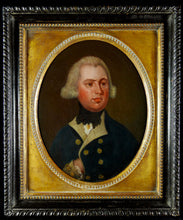Portrait of a Royal Navy Lieutenant, Circa 1795
Adding product to your cart
Overall: 37cm (14.25in) x 31.5cm (12.25cm)
In the manner of Thomas Peat (fl.1791-1831). Oil on white metal. The sitter is depicted half-length with powdered hair, black stock and white frilled chemise; his right hand tucked into his gilt buttoned full-dress blue coat. The white facings indicate the rank of lieutenant and differentiate the coat from the from the ‘undress’ version introduced at the start of the war with Revolutionary France as working rig. The button design of a fouled anchor within an ovoid border conforms to the pattern worn by lieutenants 1795 to 1812. Unsigned. Contained in a period ebonised and giltwood frame.
Read more
The present portrait bears favourable comparison to known works by Peat. Peat was a friend of the first president of the Royal Academy Sir Joshua Reynolds whose portrait he painted in miniature in 1792. The majority of Peat’s work is in miniature, but he is also known to have painted small scale oval portraits on white metal. He shared a London house with his sister, who also painted portraits. A newspaper cutting of 1791 gave their address as 290 Holborn and advertised his professional skills with the lines:
‘In striking likenesses, those talents rare,
With the ingenious Peat few can compare’
Such catchy copy perhaps attracted this naval sitter whose perilous profession offered equal prospects of oblivion or glory at the start of twenty years of almost continuous warfare. Peat was a serial exhibitor at the R.A. from 1791 to 1805, sending in works from his London houses at 184 Oxford Street in 1796 and Holborn. He later worked in the fashionable spa towns of Bath (1819-22) and Leamington (1828).






